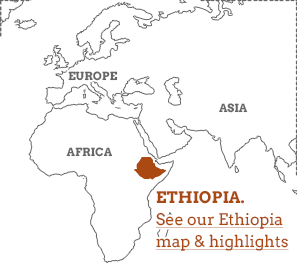Ethiopia's past can be traced back further than most, starting with the skeleton of one of the world’s oldest homonids, Lucy. In Ethiopia her name is Dinkinesh, meaning 'you are marvellous'. She rests today in Addis Ababa’s National Museum of Ethiopia along with a reconstruction of what she would have looked like when alive.
Read more Ethiopia has always been attractive to travelers; merchants sailed here from Ancient Egypt and southern Arabia to trade goods and slaves. Arabian culture undoubtedly has the greatest influence on the region; giving rise to the Afro-Asiatic language of Ge’ez, an ancestor of modern Amharic and still used in many Orthodox Christian ceremonies, much as Latin is still used in Catholicism.
Despite never having been fully colonised, Ethiopia has changed hands constantly for centuries. Each new kingdom, empire and dynasty constructed its own capital, leaving behind a staggering number of ancient cities and monuments which today draw pilgrims and travelers, mainly to the route known as the Northern Circuit. The highly advanced Aksumite kingdom, for example, was centerd around Aksum from 100 to 600AD; its stone obelisks still stand. The churches of Lalibela were chiselled out of solid rock by hand in the 12th and 13th centuries during the reign of the Zagwe dynasty – one of Ethiopia’s most mysterious, as little else remains from this time.
Gondar, with its glorious palaces, churches and gardens, was founded in the mid-17th century, but was capital of this new empire for just a century. Despite ensuing civil war, its incredible architecture was preserved.
In 1869, the opening of the Suez Canal renewed interest in the region. The Italians obtained Eritrea two decades later, but were not satisfied. As the Italians spilled over the border, Emperor Menelik united Ethiopians and defeated the Italians – a historic defeat of a European army by an African one, particularly at a time when virtually the entire continent was colonised and enslaved. Ethiopia’s reputation as a fiercely independent nation was sealed. Menelik moved forward with plans to modernise Ethiopia, with electricity, roads, a great railway and secular leadership.
However, when Mussolini came to power in Italy in the 1930s, he was keen to link up his African territories by conquering this stubborn nation. Troops invaded Ethiopia in 1935 and it fell the following year, defeated by bombs, gas and air raids, and the shocking indifference of the League of Nations. However, Ethiopian morale remained strong; the Italians occupied the country but never gained strongholds outside the main cities, and the resistance continued. Finally, with the (late and smaller than promised) assistance of Britain in 1941, Ethiopia was finally liberated from its one, brief occupation – but worse was to follow.
Motivated by political corruption, the devastating famine of the 1970s and continuing battles with Somalia and Eritrea, an extremist military group known as the Derg emerged. Seizing power, they deposed of the once-popular Emperor Haile Selassie, arrested his supporters and declared a socialist state. At least 100,000 opponents were killed in a campaign known as the 'Red Terror' and many more in the famous 1984-85 famine, as the Derg neglected to assist the worst hit areas. Opposition grew, and in 1991 the Derg was defeated by the Ethiopian People’s Revolutionary Democratic Front (EPRDF), a united group from across the country.
Under the EPRDF, Ethiopia has evolved into a relatively modern democracy, and despite ongoing skirmishes with Somalia and Eritrea along its borders, the majority of this huge country remains safe, peaceful, tolerant, and proudly uncolonised.






























